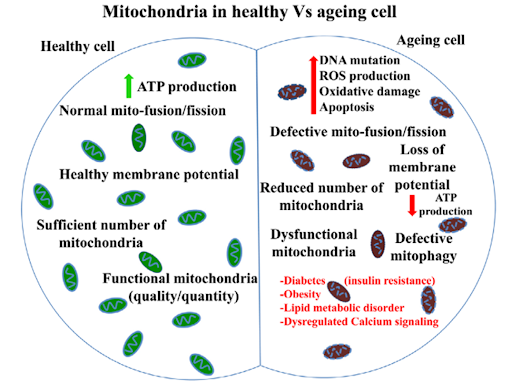
Ageing is an inevitable process that every one of us will experience. While we often relate age with wisdom and experience, it also brings a range of changes in the body, both visible and hidden. From losing the ability to chew our favorite foods comfortably to experiencing digestive issues, bone fragility, and muscle loss, the effects of ageing can influence daily life in many ways.
One of the central aspects of these changes lies in the body’s metabolism. Understanding what happens to our metabolism as we age can help us take practical steps to maintain health, strength, and vitality.
ALSO READ: How to Stop Gaining Weight As You Age?
The Hallmark of Ageing
One of the primary factors is environmental changes that cause genetic instability and alterations in the cells. These changes trigger a chain reaction in the body, leading to what is called an “antagonistic hallmark,” namely, mitochondrial dysfunction. Mitochondria are tiny structures in our cells that serve as the powerhouse of the body, producing the energy required for every function. When mitochondria fail to work efficiently, the body experiences oxidative stress, and the levels of reactive oxygen species (ROS) increase.
Mitochondrial dysfunction affects almost every metabolic process in the body. Anabolism, which is the building up of tissues and muscles, decreases. Muscle mass diminishes, leading to sarcopenia, while body fat can increase, often due to decreased nutrient intake and a sedentary lifestyle. Muscle morphology changes, causing a decline in strength. Over time, this metabolic decline can pave the way for conditions such as metabolic syndrome, which further compromise health.

Pic credits: Natarajan et al., 2020
How Ageing Affects Metabolism
As we age, mitochondrial function declines, reducing ATP production and energy for the body. Cells lose their ability to regenerate, slowing recovery from illness, injury, or daily wear. Digestive changes, including reduced saliva production and shifts in the gut microbiome, can impair nutrient absorption, sometimes leading to malnutrition. To meet energy needs, the body may break down muscle tissue, causing sarcopenia, which weakens strength, mobility, and overall physical function.
Bone density also decreases with age, increasing the risk of fractures and osteoporosis. Muscle loss can affect chewing, while poor oral health further limits nutrition, compounding health challenges and overall well-being.
Consequences of Metabolic Decline
The changes described above are interconnected. Mitochondrial dysfunction leads to reduced energy production, which results in less activity, slower metabolism, and impaired regeneration of cells. Low energy production can also trigger hormonal imbalances and inflammation, which worsen muscle loss and bone fragility.
The decline in muscle mass and strength reduces the ability to perform daily activities independently. Even tasks like walking, climbing stairs, or lifting objects become challenging. Sarcopenia and osteoporosis together increase the risk of falls and injuries, making older adults more vulnerable. Digestive inefficiency, coupled with low nutrient intake, further accelerates the decline in health, creating a cycle of frailty that can be difficult to break without proper intervention.
Related: Osteoporosis: Causes and Management
Managing Ageing-Related Declines
The good news is that many of the declines associated with ageing can be managed or slowed down with targeted strategies involving nutrition and physical activity. While the body naturally undergoes changes, adopting certain measures can help maintain strength, mobility, and overall quality of life.
1. Focus on Easy-to-Consume Foods
As chewing and digestion become more difficult, it is important to choose foods that are easy to consume. Soft, mushy purées or soups are excellent options that allow older adults to meet their nutritional needs without strain. Ensuring that food is palatable and easy to chew can encourage adequate intake and prevent malnutrition.
2. Adequate Protein Intake
Protein plays a crucial role in preserving muscle mass and strength. For older adults, it is recommended to consume at least 1.2 to 1.8 grams of protein per kilogram of body weight daily. Protein supplements, such as whey, can provide high-quality protein that is easy to digest and absorb, supporting muscle health and preventing sarcopenia.
3. Supplements for Nutrient Deficiencies
Ageing bodies may struggle to absorb nutrients from food, making supplementation important. Calcium and vitamin D are particularly critical for maintaining bone health, while multivitamins can help fill gaps in the diet. All supplements should be taken under the guidance of a physician to ensure safety and effectiveness.
4. Adequate Fiber Intake
Digestive issues are common with ageing, and fiber can help regulate bowel movements and improve gut health. Supplements like psyllium husk can be added to the diet to ensure sufficient fiber intake, supporting digestive efficiency and nutrient absorption.
5. Healthy Fats
Including unsaturated fats, especially omega-3 fatty acids, can help reduce inflammation and support overall cellular health. Omega-3s are beneficial for both metabolic function and cardiovascular health, making them a valuable addition to the diet.
6. Physical Activity
Maintaining an active lifestyle is one of the most effective ways to combat the effects of ageing. A mix of neuromotor, aerobic, strength, and flexibility exercises, tailored to an individual’s capacity, can help preserve muscle mass, improve bone density, and maintain mobility. Regular physical activity also supports energy metabolism, mitochondrial function, and overall well-being.
ALSO READ:
Final Thoughts
Ageing naturally brings metabolic and physiological changes, but it doesn’t have to mean a decline in quality of life. Understanding how ageing affects metabolism, from reduced energy production and muscle loss to bone density decline and digestive changes, allows us to take proactive steps to manage these effects.
A balanced diet, adequate protein, fiber, healthy fats, supplements if needed, and regular exercise can slow or manage these changes. By addressing these areas consistently, older adults can maintain strength, energy, and independence, turning knowledge of ageing into practical habits for long-term health.
References:
- López-Otín, C. et al. (2013) ‘The Hallmarks of ageing’, Cell, 153(6), pp. 1194–1217. doi: 10.1016/J.CELL.2013.05.039.
- Bartke, A. et al. (2021) ‘Energy Metabolism and ageing’, The World Journal of Men’s Health, 39(2), pp. 222–232. doi: 10.5534/WJMH.200112.
- Natarajan, V. et al. (2020) ‘Mitochondrial Dysfunction in Age-Related Metabolic Disorders’, Proteomics, 20(5–6), pp. 1–11. doi: 10.1002/pmic.201800404.
- Rebelo-Marques, A. et al. (2018) ‘ageing hallmarks: The benefits of physical exercise’, Frontiers in Endocrinology, 9(MAY), pp. 1–15. doi: 10.3389/fendo.2018.00258.